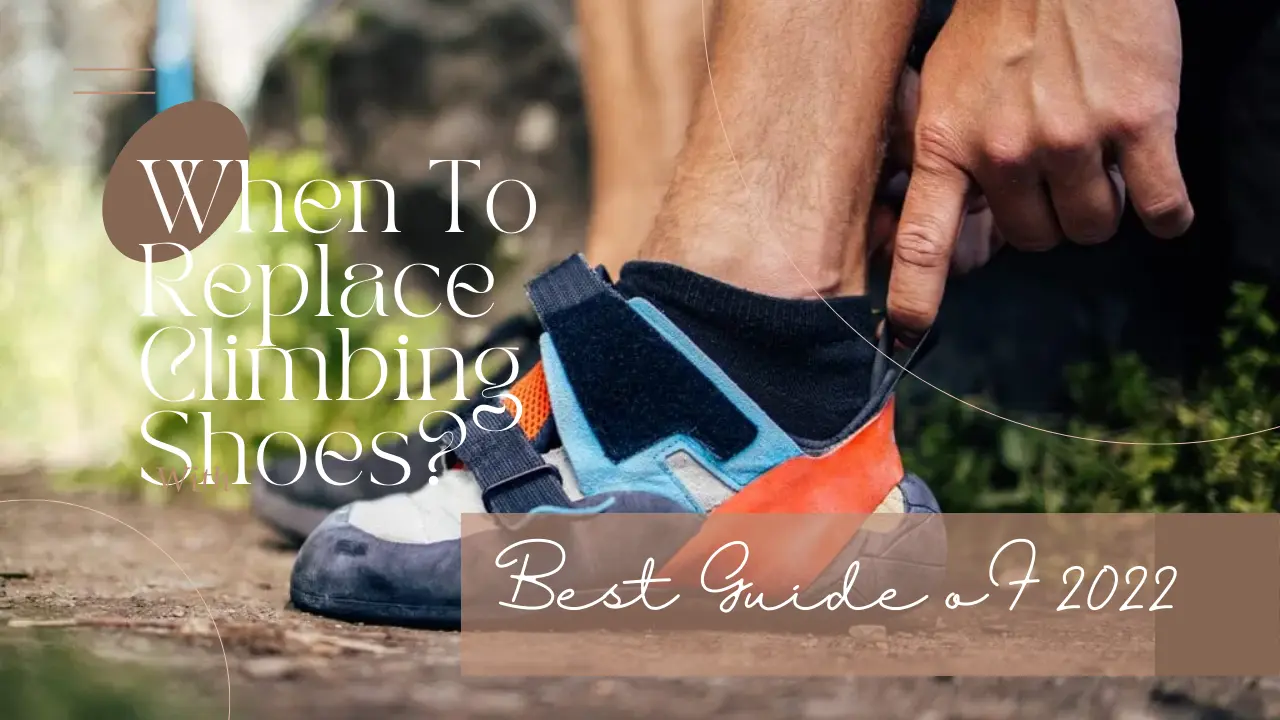Climbing shoes are a critical piece of gear for any climber, but they don’t last forever. Over time, the soles will wear down and the shoes will lose their shape, making them less effective at gripping the rock. This raises the question: how long do climbing shoes last? And when should you replace your climbing shoes?
In this article, I’ll discuss certain signs that it’s time to consider getting a new pair. Remember that the longevity of your climbing shoes is determined by a variety of factors. However, regardless of the circumstances, safety should always be your first priority. Keep reading as I’ll explore this topic to assist you make an informed decision on when to replace climbing shoes.
Also, read this: How to WaterProof Mesh Shoes? | Best Methods Of 2022
How Long do Climbing Shoes Last?
The longevity of climbing shoes is mostly determined by their outsole rubber. A high-quality pair of climbing shoes should last until the rubber thins out. This duration is mostly determined by the frequency of your climbing workouts, the accuracy of your footwork, and the softness of your shoes. Interestingly, most climbing shoes can be resoled, so with proper care, they can endure for several years, even with regular use.
However, like with everything in life, exceptions do occur. For example, if you climb more than three times a week with softer shoes, you may notice that they wear out before the six-month mark. On the other hand, if you climb less than twice a week with a pair of strong climbing shoes, they should last at least a year, if not longer, depending on how frequently you climb.
Here Is When to Replace Climbing Shoes?
Climbing shoes are one of the most important pieces of gear for climbers, and it’s important to have a pair that fits well and is comfortable to wear. But just like any other piece of gear, climbing shoes will eventually wear out and need to be replaced.
There are a few things to keep in mind when deciding when to replace your climbing shoes. First, take a look at the sole of your shoes. If the rubber is starting to wear thin, it’s probably time for a new pair. Second, consider how comfortable your shoes are.
If they’re starting to hurt your feet or feel too tight with thin rubber, it’s probably time for a new pair. Third, think about how often you use your shoes.
Tearing of Shoes
Climbing shoes see a lot of wear and tear. The average climber will go through 2-3 pairs of shoes per year. Depending on how often you climb, your shoes could last anywhere from 6 months to 2 years. But how do you know when it’s time to buy new climbing shoes?
There are a few signs that indicate it’s time for new shoes. If your shoes are tearing, if the soles are coming off, or if they’re just not fitting as well as they used to, it’s probably time to get a new pair.
Another good indicator is if your climbing performance has been suffering. If you’re not making the progress you used to or if you’re consistently slipping, it could be time for a new pair of shoes. If you’re not sure if your shoes need to be replaced.
Delamination of Shoes
Delamination is the process of separating layers of material that are bonded together. It can occur in a variety of materials, including shoes. Shoe delamination is often caused by water damage. When water seeps into the layers of the shoe, it can cause the material to swell and separate.
Another common cause of delamination is wear and tear. Over time, the layers of the shoe can rub together and weaken the bonds that hold them together. If you notice that your shoes are starting to delaminate, you’ll need to take action to prevent the problem from getting worse.
First, try to remove the source of the water damage or wear and tear. If that’s not possible, you can try to repair the shoes with glue or another adhesive. If the problem is severe, you may need to replace the shoes altogether.
Time to Level Up
As your climbing experience expands, you’ll begin to explore your limitations and take on more difficult climbs. You may discover that your present shoes, which suited you well as a beginning, are no longer giving the support or precision you want. This is a strong indication that it is time to change your climbing shoes with ones that match your new skill level.
Upgrading your climbing shoes is a vital step toward progressing. Advanced shoes provide advantages such as increased precision, grip, and comfort for lengthy climbs. These characteristics can significantly improve your performance and enable you to push your limits further.
Process of Delamination
Delamination normally starts with subtle signs. You may notice the edges of the soles peeling away or little bubbles appearing beneath the surface of the rubber. Over time, these minor flaws might progress to greater separations, with the rubber sole eventually peeling completely.
Delamination grows more quickly in shoes that are oftenly worn on rough terrain or in hot weather, as both of these situations can put extra strain on the glue that holds the shoe together. Furthermore, shoes that are not properly cared for, such as being left in moist environments or not being allowed to dry completely after use, are more prone to delamination.
Time to Level Up
As your climbing experience expands, you’ll begin to explore your limitations and take on more difficult climbs. You may discover that your present shoes, which suited you well as a beginning, are no longer giving the support or precision you want. This is a strong indication that it is time to change your climbing shoes with ones that match your new skill level.
Upgrading your climbing shoes is a vital step toward progressing. Advanced shoes provide advantages such as increased precision, grip, and comfort for lengthy climbs. These characteristics can significantly improve your performance and enable you to push your limits further.
How to Take Care of Climbing Shoes
Taking care of your climbing shoes is important for extending their life and maintaining their function. Here are some guidelines for properly caring for your climbing shoes:
- Keep Them Clean: After each climbing session, wipe your shoes. Remove any dirt or debris, as they might deteriorate the rubber soles over time. Use a gentle brush and light soap if necessary, but avoid harsh chemicals that could harm the material.
- Dry Them Properly: Never leave your shoes in a moist or humid area, as this might promote the growth of bacteria and fungi. Instead, let them to dry in a well-ventilated place. Avoid direct sunlight and heat sources, which can cause the rubber to dry up and break.
- Store Them Correctly: When not in use, put your shoes somewhere cool and dry. Avoid keeping them in your car or in a bag for an extended time. Proper preservation preserves the shape of the shoes and keeps the rubber from degrading.
- Avoid Unnecessary Wear: Try to wear only your climbing shoes when climbing. Walking around on rocky terrain can easily wear out the soles.
- Consider Resoling: If the soles of your shoes are worn but the upper is still in good shape, consider having them resoled. This can dramatically extend the life of your shoes while also saving you money.
Conclusion: When to Replace Climbing Shoes
In conclusion, understanding when to replace your climbing shoes is an important component of climbing. It not only provides peak performance but also keeps you safe throughout climbs. Understanding the physical condition of your shoes becomes an important element of your climbing development as you improve. So, always be aware and make informed choices about your climbing gear.
Also, read this: Best Guide Of How To Waterproof Shoes With Wd40 | 2022
Frequently Asked Questions
How does the fit of climbing shoes change over time?
If your shoes’ rubber is thinning, has smooth areas, or the edge is softened rather than sharp, it’s time to replace or resole them.
Should you be able to shake your toes on hiking shoes?
Over time, climbing shoes can extend and lose their snug fit, affecting performance. If they feel too loose and lack support, it’s time for a new pair.
Are there any risks in continuing to use worn-out climbing shoes?
Yes, wearing worn-out shoes can lower your grip, increase the danger of slipping, and cause foot discomfort or injury, jeopardizing your climbing safety.

